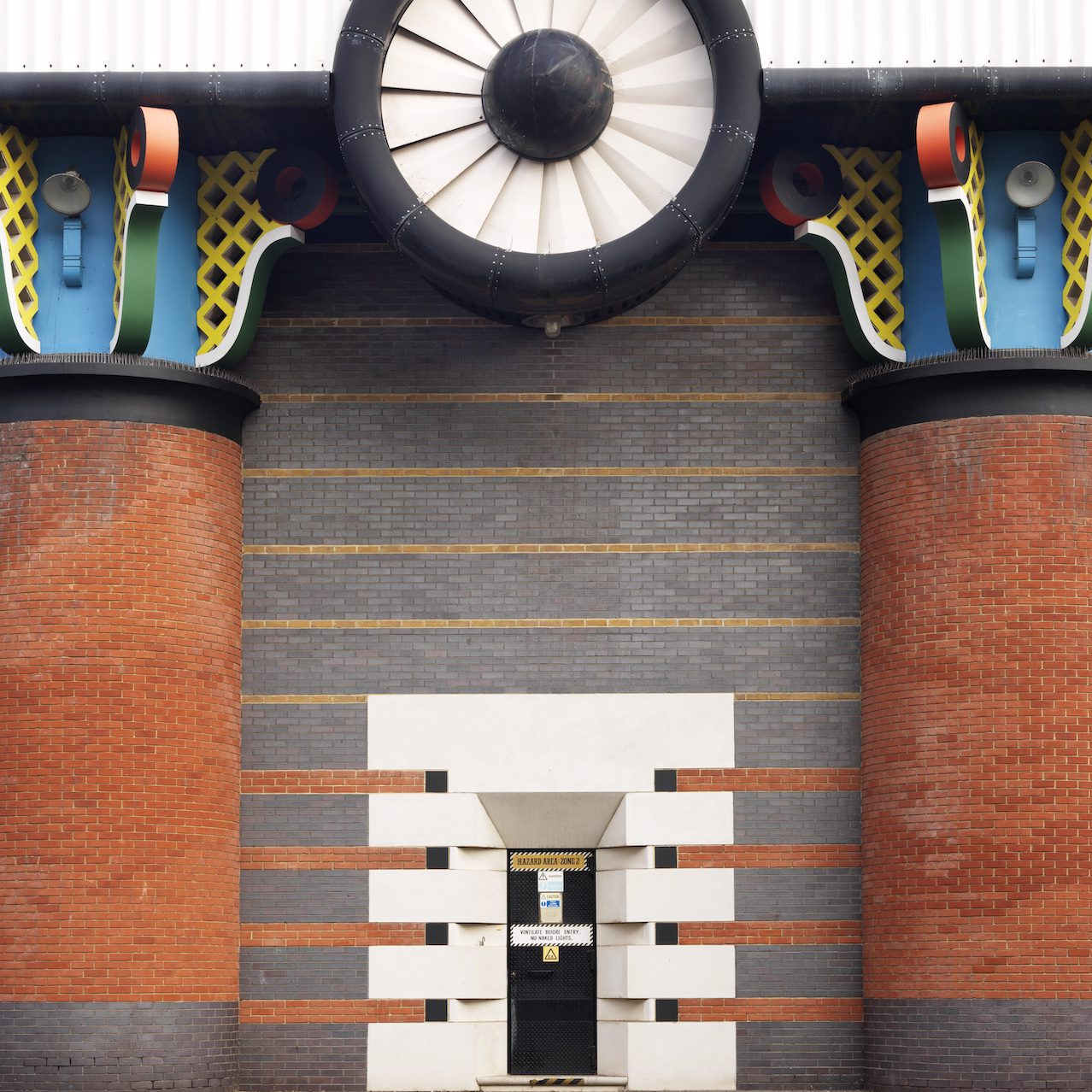A new publication from the Twentieth Century Society by historian Geraint Franklin charts John Outram’s extraordinary career. Charles Holland enjoys the first major study of a highly idiosyncratic architect who remains impossible to categorise.
Isle of Dogs Pumping Station by John Outram
John Outram gave one of the strangest lectures I have ever attended. It was only my second year of studying architecture and its mix of surreal humour and personal mythology was compelling. His work seemed to emanate from an intense, metaphysical world all of its own. His buildings – which are generally described as Post Modern but which really evade such easy categorisation – are genuinely unique. Remarkably no previous book on his work exists so this new publication from the Twentieth Century Society by historian Geraint Franklin is especially welcome.
Outram studied architecture in the 1950s, initially at the Polytechnic of Central London before moving to the Architectural Association, at that point indisputably the most exciting school of architecture in the UK. At the AA he came into contact with a group of highly influential tutors including John Killick, James Gowan and Peter Smithson. He also rubbed shoulders with the nascent Archigram group who included his 1959 design for a concert hall in their first published issue. Following graduation, he worked for a variety of commercial practices as well as the London County Council before setting up John Outram Architects (JOA) in 1974.
The 1960s seems to have been a period of significant reappraisal during which he came to reject much of the Archigram milieu, developing instead a singular vision that placed architecture within an allegorical framework combining the origin myths of classicism with a highly decorative design language. JOA’s richly symbolic architecture was developed initially via a series of utilitarian briefs. Early projects, such as the industrial buildings he designed for the Poyle Trading Estate near Heathrow in 1976, turned this limitation into a virtue. A series of simple sheds made of profiled metal sheeting and engineering brick were elevated into classical temples set in an Arcadian landscape of lorry turning circles.
Isle of Dogs Pumping Station by John Outram
This initial trajectory came to joyful fruition in the form of the Isle of Dogs Pumping Station (1988), a building that tends to win round even the most ardent sceptics. One reason for this is that the building confounds criticisms of Post Modernism as something flimsy and scenographic. JOA’s Pumping Station is solid, emphatic and un-ironic. It sits foursquare and imposing, its polychromatic colour scheme somehow only adding to its physical presence. The only irony – unfortunately there has to be one – is that Outram unashamedly developed his design language as a way of providing an illusion of solidity and depth for buildings that would otherwise have been lightweight and throwaway. His so-called Robot Order of columns – giant circular drums containing both structure and services – epitomises this acceptance of the realities of contemporary construction combined with an ambitious symbolic language.
By contrast, New House, the luxurious home JOA designed in the East Sussex countryside for Tetra Pak billionaire Hans Rausing is seemingly unencumbered by budgetry constraints. The exterior of this single-storey house is clad in a dense collage of ‘blitzcrete’, Outram’s personal form of pre-cast concrete incorporating colourful fragments of other materials, while the interior has hints of both Art Deco and Sir John Soane, a cross between Eltham Palace and Lincoln’s Inn Fields. Despite its exuberant materiality, the house ultimately appears as enigmatic and inscrutable as its notoriously reclusive owner.
Judge Institute of Management by John Outram
During the 1980s and early ’90s, JOA produced a number of designs for office buildings in the City of London. These were conceived as allegories of the construction process where the absent primordial site is made present in both the spatial and decorative scheme of the architecture. Outram imagined the interior as a carved-out river valley where the column grid represents a petrified grove of trees and the roofline becomes an elevated version of the lost arcadia below. The resulting architecture is like an allegorical machine assembling itself out of its own mythology.
The apotheosis of Outram’s work came in the form of the Judge Institute of Management in Cambridge, a wildly brilliant assemblage that incorporates an existing building into a spectacular composition. The interior surfaces are encrusted with all kinds of decorative techniques including more ‘blitzcrete’ and its derivative ‘doodlecrete’. The central atrium is like little else contemporary architecture has produced: sculptural and ornamental, spatial and iconographic, serious and joyful.
Judge Institute of Management by John Outram
John Outram is that rare thing, a British architect who has developed a coherent theoretical position alongside a compelling formal language. Geraint Franklin’s book is an excellent dissection of both. The author is clearly enthused by the work but he is never hagiographic. He describes the buildings in ways that are enjoyable and accessible without ever being simplistic. The richness of the architecture and the idiosyncratic nature of Outram’s oeuvre is challenging but Franklin does the work full justice. It is an excellent addition to the Twentieth Century Society series, expanding its remit to include the work of a brilliant, impossible to categorise, architect.
More images
Source: Architecture Today







